[English] 日本語
 Yorodumi
Yorodumi- EMDB-43895: nsEM of HIV-1 16055 SOSIP.v8.3 Env in Complex with Week 6 Base pA... -
+ Open data
Open data
- Basic information
Basic information
| Entry |  | |||||||||
|---|---|---|---|---|---|---|---|---|---|---|
| Title | nsEM of HIV-1 16055 SOSIP.v8.3 Env in Complex with Week 6 Base pAb (Rabbit ID: 2464) | |||||||||
 Map data Map data | ||||||||||
 Sample Sample |
| |||||||||
 Keywords Keywords | HIV / Polyclonal / Antibodies / nsEMPEM / Rabbit / VIRAL PROTEIN | |||||||||
| Biological species |    Human immunodeficiency virus 1 Human immunodeficiency virus 1 | |||||||||
| Method | single particle reconstruction / negative staining / Resolution: 25.0 Å | |||||||||
 Authors Authors | Brown S / Antansijevic A / Ward AB | |||||||||
| Funding support |  United States, 2 items United States, 2 items
| |||||||||
 Citation Citation |  Journal: Sci Immunol / Year: 2025 Journal: Sci Immunol / Year: 2025Title: Anti-immune complex antibodies are elicited during repeated immunization with HIV Env immunogens. Authors: Sharidan Brown / Aleksandar Antanasijevic / Leigh M Sewall / Daniel Montiel Garcia / James Ferguson / Philip J M Brouwer / Rogier W Sanders / Andrew B Ward /    Abstract: Vaccination strategies against HIV-1 aim to elicit broadly neutralizing antibodies (bnAbs) using prime-boost regimens with HIV envelope (Env) immunogens. Epitope mapping has shown that early antibody ...Vaccination strategies against HIV-1 aim to elicit broadly neutralizing antibodies (bnAbs) using prime-boost regimens with HIV envelope (Env) immunogens. Epitope mapping has shown that early antibody responses are directed to easily accessible nonneutralizing epitopes on Env instead of bnAb epitopes. Autologously neutralizing antibody responses appear upon boosting, once immunodominant epitopes are saturated. Here, we use electron microscopy-based polyclonal epitope mapping (EMPEM) to elucidate how repeated immunization with HIV Env SOSIP immunogens results in the generation of Ab2α anti-idiotypic antibodies in rabbits and rhesus macaques. We present the structures of six anti-immune complex antibodies and find that they target idiotopes composed of framework regions of antibodies bound to Env. Examination of cryo-electron microscopy density enabled prediction of sequences for an anti-immune complex antibody, the paratope of which is enriched with aromatic amino acids. This work sheds light on current vaccine development efforts for HIV, as well as for other pathogens in which repeated exposure to antigen is required. | |||||||||
| History |
|
- Structure visualization
Structure visualization
| Supplemental images |
|---|
- Downloads & links
Downloads & links
-EMDB archive
| Map data |  emd_43895.map.gz emd_43895.map.gz | 20.7 MB |  EMDB map data format EMDB map data format | |
|---|---|---|---|---|
| Header (meta data) |  emd-43895-v30.xml emd-43895-v30.xml emd-43895.xml emd-43895.xml | 14.3 KB 14.3 KB | Display Display |  EMDB header EMDB header |
| Images |  emd_43895.png emd_43895.png | 450.4 KB | ||
| Filedesc metadata |  emd-43895.cif.gz emd-43895.cif.gz | 4.2 KB | ||
| Others |  emd_43895_half_map_1.map.gz emd_43895_half_map_1.map.gz emd_43895_half_map_2.map.gz emd_43895_half_map_2.map.gz | 20.7 MB 20.7 MB | ||
| Archive directory |  http://ftp.pdbj.org/pub/emdb/structures/EMD-43895 http://ftp.pdbj.org/pub/emdb/structures/EMD-43895 ftp://ftp.pdbj.org/pub/emdb/structures/EMD-43895 ftp://ftp.pdbj.org/pub/emdb/structures/EMD-43895 | HTTPS FTP |
-Related structure data
- Links
Links
| EMDB pages |  EMDB (EBI/PDBe) / EMDB (EBI/PDBe) /  EMDataResource EMDataResource |
|---|
- Map
Map
| File |  Download / File: emd_43895.map.gz / Format: CCP4 / Size: 27 MB / Type: IMAGE STORED AS FLOATING POINT NUMBER (4 BYTES) Download / File: emd_43895.map.gz / Format: CCP4 / Size: 27 MB / Type: IMAGE STORED AS FLOATING POINT NUMBER (4 BYTES) | ||||||||||||||||||||||||||||||||||||
|---|---|---|---|---|---|---|---|---|---|---|---|---|---|---|---|---|---|---|---|---|---|---|---|---|---|---|---|---|---|---|---|---|---|---|---|---|---|
| Projections & slices | Image control
Images are generated by Spider. | ||||||||||||||||||||||||||||||||||||
| Voxel size | X=Y=Z: 1.677 Å | ||||||||||||||||||||||||||||||||||||
| Density |
| ||||||||||||||||||||||||||||||||||||
| Symmetry | Space group: 1 | ||||||||||||||||||||||||||||||||||||
| Details | EMDB XML:
|
-Supplemental data
-Half map: #2
| File | emd_43895_half_map_1.map | ||||||||||||
|---|---|---|---|---|---|---|---|---|---|---|---|---|---|
| Projections & Slices |
| ||||||||||||
| Density Histograms |
-Half map: #1
| File | emd_43895_half_map_2.map | ||||||||||||
|---|---|---|---|---|---|---|---|---|---|---|---|---|---|
| Projections & Slices |
| ||||||||||||
| Density Histograms |
- Sample components
Sample components
-Entire : Rabbit Polyclonal Antibody - Base Epitope
| Entire | Name: Rabbit Polyclonal Antibody - Base Epitope |
|---|---|
| Components |
|
-Supramolecule #1: Rabbit Polyclonal Antibody - Base Epitope
| Supramolecule | Name: Rabbit Polyclonal Antibody - Base Epitope / type: complex / ID: 1 / Parent: 0 / Macromolecule list: #1-#6 |
|---|---|
| Source (natural) | Organism:  |
-Supramolecule #2: HIV-1 16055 SOSIP.v8.3 Env
| Supramolecule | Name: HIV-1 16055 SOSIP.v8.3 Env / type: complex / ID: 2 / Parent: 1 |
|---|---|
| Source (natural) | Organism:   Human immunodeficiency virus 1 Human immunodeficiency virus 1 |
-Experimental details
-Structure determination
| Method | negative staining |
|---|---|
 Processing Processing | single particle reconstruction |
| Aggregation state | particle |
- Sample preparation
Sample preparation
| Buffer | pH: 7.4 |
|---|---|
| Staining | Type: NEGATIVE / Material: Uranyl Formate |
| Grid | Model: Homemade / Material: COPPER / Mesh: 400 / Support film - Material: CARBON / Support film - topology: CONTINUOUS / Pretreatment - Type: PLASMA CLEANING |
- Electron microscopy
Electron microscopy
| Microscope | FEI TECNAI F20 |
|---|---|
| Image recording | Film or detector model: TVIPS TEMCAM-F416 (4k x 4k) / Detector mode: COUNTING / Average electron dose: 25.0 e/Å2 |
| Electron beam | Acceleration voltage: 120 kV / Electron source:  FIELD EMISSION GUN FIELD EMISSION GUN |
| Electron optics | Illumination mode: FLOOD BEAM / Imaging mode: BRIGHT FIELD / Nominal defocus max: 1.5 µm / Nominal defocus min: 1.0 µm |
| Sample stage | Cooling holder cryogen: NITROGEN |
| Experimental equipment | 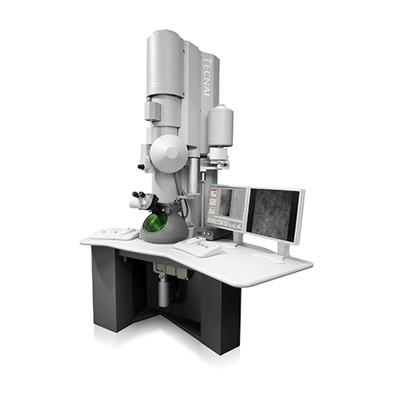 Model: Tecnai F20 / Image courtesy: FEI Company |
- Image processing
Image processing
| Startup model | Type of model: EMDB MAP EMDB ID: Details: Low pass filtered to 40 angstroms. |
|---|---|
| Final reconstruction | Applied symmetry - Point group: C1 (asymmetric) / Resolution.type: BY AUTHOR / Resolution: 25.0 Å / Resolution method: FSC 0.143 CUT-OFF / Software - Name: RELION (ver. 3.0) / Number images used: 1332 |
| Initial angle assignment | Type: MAXIMUM LIKELIHOOD |
| Final angle assignment | Type: MAXIMUM LIKELIHOOD |
 Movie
Movie Controller
Controller





















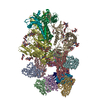


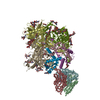
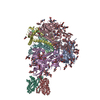
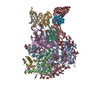
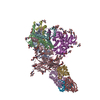
 Z (Sec.)
Z (Sec.) Y (Row.)
Y (Row.) X (Col.)
X (Col.)





































